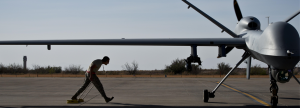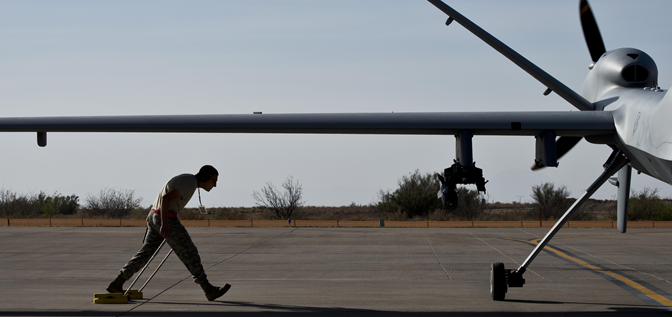Robots fascinate humans. They abound in movies: Star Wars, the Terminator, the Matrix. They are a foil for the human condition. In rosy predictions they are like Star Trek’s Data, “perfect” in strength and intellect yet void of emotion. In dystopian futures, killer robots are poetic justice. Created by humanity, robots attempt to annihilate their creators. If told killer robots exist in the U.S. arsenal, most Americans would probably think of “drones.” The name sounds robotic; it implies automaton behavior. Drones lack an onboard crew, and just like robots, drones fascinate Americans. In one important way, however, drones are not robots: they are flown by humans; they are just flown by remote control, but this creates a problem all of its own.
The Armed Forces are not even sure how to deal with drone pilots. The pilots play a pivotal role in combat operations. They make life or death decisions. They press the button to fire missiles. They probably engage in more “lethal actions” than other air units at present. Nevertheless, most fellow service members and the public at large do not think drone pilots hold “combat” jobs. Our system cannot square the responsibilities these service members have with the lack of surrounding danger.
The presence of danger has always been a defining characteristic of war and particularly in the way civilians see the armed forces. While Americans generally no longer glorify the taking of spoils, we do glorify success in the face of adversity and particularly danger. American society regularly “thanks” service members with things like recognition at sporting events and military discounts. These types of recognition purposely avoid mention of the policies those being thanked implement: “Support the Troops, whether you support the war or not.” But that approach only works if service members are seen to represent honorable values like service and sacrifice. Take away the danger and something of those values seems to disappear too.
 Of course, some soldiers have always been relatively safe, performing jobs in the rear areas. Most civilians do not see past the uniform, but service members know who is actually at the front (though ironically the insurgencies of the past 40 years have eroded the difference). For those actually pulling the trigger, danger was always at least reciprocal if not near. While an artilleryman might not have been within rifle range of the enemy, he was in range of the enemy’s artillery. Even ballistic missile crews in the United States were held at risk by their Soviet counterparts during the Cold War.
Of course, some soldiers have always been relatively safe, performing jobs in the rear areas. Most civilians do not see past the uniform, but service members know who is actually at the front (though ironically the insurgencies of the past 40 years have eroded the difference). For those actually pulling the trigger, danger was always at least reciprocal if not near. While an artilleryman might not have been within rifle range of the enemy, he was in range of the enemy’s artillery. Even ballistic missile crews in the United States were held at risk by their Soviet counterparts during the Cold War.
Drone pilots seem different because there is no reciprocity, but even that does not quite make drone pilots unique. The U.S. government has long looked to reduce danger to service members. Drones are only the latest idea. As the old Army saying goes “Why send a man if you can send a bullet?” The Navy has fully embraced this idea. The ships that launch manned aircraft and Tomahawk cruise missiles (a true killer robot) from the Mediterranean are in no more danger today than if they were training off the coast of California or Virginia. The closest most shipboard sailors have come to fighting in the last 10 years is pressing a button and then rushing to the TV in hopes that CNN will cover the resulting explosions. The Navy still uses the Iranian mine-laying operations in the late 1980s to justify for “imminent danger” pay for crews. If the Navy has not faced the same challenges as the drone community it is principally because distance from American shores obscures what is going on. A similar lack of reciprocity exists for most air and even some ground forces, both masked by distance. Indeed, this lack of reciprocity in many aspects of warfare is inherent to the asymmetric wars in which the United States has engaged.
Wars of the future may ameliorate this problem in some situations but will likely exacerbate in most. As the United States again faces the potential of great power conflict, the likelihood it will face an adversary with advanced air, land, and sear forces greatly increases. Nonetheless, a key lesson of the past decades has been that those who fight the United States on its own terms lose. This situation is likely to remain unchanged for several decades. Thus even great power competitors will seek to field forces that challenge American forces asymmetrically which made lead to situations lacking reciprocity even as the United States continues to develop technology to further protect its service members from danger.
Drones illuminate a problem which has already existed and will only grow in the future: In a society that professes not to value military spoils, how does the relationship with the armed forces change as service members become increasingly removed from danger?
Long-range weapons like artillery, naval gunfire, or close air support in a combined arms environment may suggest an answer. The Marine Corps has best developed this idea. Every Marine who is not primarily a rifleman understands his or her purpose is to support rifleman. For the naval gunnery liaison officer, his or her job directing the shore bombardment in support of forces ashore becomes more important because that officer operates from the relative safety of the ship but his or her actions mean life or death for forces ashore. At their best, these units draw their identity from the support and protection they provide to those in the greatest danger, and those in danger would never deny the importance of that support when well executed.
Without a doubt, danger will never disappear, nor should we reduce efforts to lessen it, but we must begin to think about a how the armed forces will relate to society as fewer service members go in harm’s way. While drones may not actually be robots, in one at least one way their arrival seems to have played a similar role: Drones have highlighted an all too human problem about how people relate to war.
Erik Sand is a Surface Warfare Officer in the U.S. Navy and a graduate of Harvard University. His opinions are his own and do not represent the views of the U.S. Navy or Department of Defense.





 Natalie Sambhi
Natalie Sambhi
